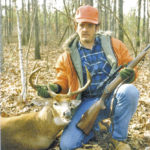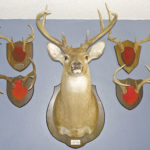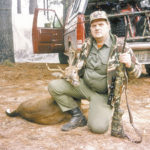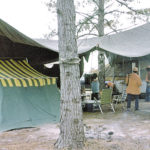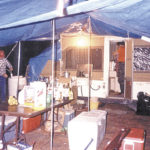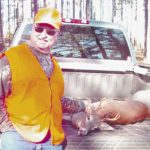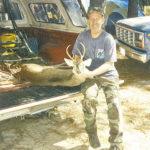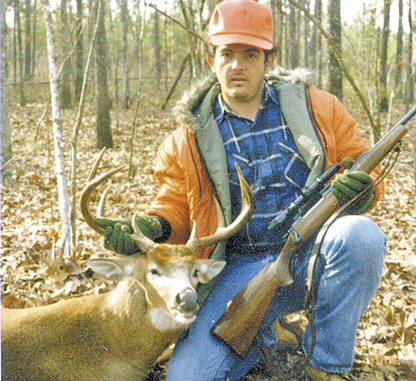
This group has been hunting WMAs for four decades, and they’ve mastered the skills to put some really nice bucks on the wall. More importantly, they have an absolute blast while they’re doing it.
Did you ever hear of Wolf Creek, Duck Slough, Muddy Bayou, Pocosin, Whiskey Chitto creeks, Dugdemona River, Chaney and Choctaw Creek, Upper and Lower Sunk lakes? Or how about Hunter Creek, Ben’s Creek, Mississippi Bayou, Sally Miller Pond or Louisiana Cypress Canal?
If you know of one or two of them, you can probably deduce that these are some prime deer hunting locations in the state. All of these locations are within Louisiana wildlife management areas. Louisiana has 58 of such WMAs, and numerous other preserves and national wildlife refuges.
In addition to the available hunting areas, most WMAs offer camping facilities. The campsites are, for the most part, primitive, and provide only for the use of tents, pop-ups, camping trailers or motor homes that are self sufficient at the campsite. Most sites do not offer electric power, water and sewerage hookups, or in some cases even comfort stations or garbage-collection sites.
They do, however, offer a unique opportunity for the properly prepared outdoorsman to really hunt an area as well as to experience what a primitive camp site means. It is an opportunity to expose your children and friends to camping and hunting at the same time.
Our group has been hunting these state WMA sites since the early 1960s. It is an experience that we truly enjoy. Yes, we have other private land and leases that we hunt, but we have found what the terms “sportsman” and “hunter” really mean when hunting the WMAs. It takes skill and instinct to find the hotspots and be able to hunt these locations with success, at the same time maintaining a primitive camp site on the WMA grounds.
We have met many hunters who have become lifelong friends at some of these camp grounds, and many astute hunters who have taught us their techniques. We have also met a ton of greenhorns.
Our season usually starts with a deer hunting meeting sometime in August or early September. The hunting meeting was once a means of determining who was going to hunt and what vehicles we would bring for the campsite for the coming season. Naturally, the menu for the trip and other necessary gear that was needed would be covered.
I usually provide the necessary aerial and topo maps and as the seasons and regulations for the WMA, as well as lights, ropes, a table, water jugs, a wheeled game carrier and sometimes a cook stove. Others would volunteer to provide the tarps, shovels, poles, stoves, additional lights and other items necessary for the campsite.
Over the last 20 years, most of the reasons for the meeting have become inconsequential as we know who has what equipment and who will be making the hunt. The meeting now is really an excuse for the group to get together for an abbreviated evening of barbecue, snacks and high tales of the hunting events of yesteryear.
The nucleus of our group began in 1964 with four of us venturing out of the Southeast Louisiana swamplands to the piney hill country. It would be, we thought, a great diversion from the swamps, hip boots and pirogues that normally were part of our deer hunting. One of the group at that time had a 1957 Cadillac with plenty of room for four guys and some gear that was offered for transportation. That year it was to serve as our base vehicle. Yeah, can you imagine that? A Cadillac in the woods.
Our group began hunting the Fort Polk GMA. Back then, the Louisiana-owned and leased hunting areas were called Game Management Areas. It has since changed to cover all types of wildlife activities.
We decided on the Fort Polk GMA as it was one of the better piney woods locations where many deer were harvested and where one of our group, our resident “Old Man,” Dietz, knew some of the lay of the land in the GMA. More important was a contact he had in nearby Leesville for a rented room. This was by far the deciding factor for the Fort Polk choice as none of us had tents or camping trailers.
A retired Leesville school teacher rented a room or two to the group each year. Each room had a double bed and two or three roll-away cots, with a bathroom down the hall. She had a few rules, which consisted of no alcohol, no rowdiness and lights out by 10 p.m.
Back then, our days off were a premium as we were all working family men. So we would be on the road Thanksgiving Day to hunt the either-sex days of Friday, Saturday and Sunday, returning home the following Monday.
Fort Polk GMA was just gearing up for the Vietnam War as a prime U.S. Army training center, and there were plenty of additional rules for hunters. The state had instituted a daily check-in and check-out procedure for each day of the hunt. I can remember getting up at 3:30 a.m. in Leesville, and driving to the Fort Polk Rod and Gun Club, which was located on the base, and getting into a line with more than 1,200 other hunters, just to get our Special Permit issued
Back then, the state required that you surrender your hunting license and that a numbered daily permit be issued. That was a very time-consuming procedure. Sometimes you were standing in the line for over an hour just to get checked in. At the end of the day, you were required to turn in the permit and retrieve your hunting license. All deer had to be weighed and tagged by the LDWF agents at a designated location.
Because it was, and still is, a military base, only certain areas were open to hunting. The block areas were posted the day before. Hunting on the GMA was only allowed in the designated areas. The hunting areas were very strictly enforced by LDWF and the military police.
A particular incident about the closed-area hunting is usually retold at all of our hunting meetings and to anybody who would listen and surely to anyone who now visits our camp site.
“Old Man” Dietz had a particular favorite spot just off of Whiskey Chitto Creek in the GMA. Checking the day before, he was delighted to see that the area he wanted to hunt was to be an open hunting area. We, however, also noted that the area adjacent to the open area was closed to hunting. A firebreak trail separated the two areas.
That year we were using his wife’s 1963 Chevy, so according to him, that was where we were going to hunt. After checking in, we proceeded to the Whiskey Chitto Creek area. We parked on a hill near the trail entrance, and he took off from the car, chastising us not to follow him. Naturally, we went in an opposite direction.
Later reassembling at the vehicle at the designated time for lunch, we were astounded to see him there. He had already eaten his corned beef and yellow mustard sandwich.
He informed us that we were moving to another open location for the afternoon hunt. When asked why, he said with disgust that he was settled in against a tree a few yards from the creek near the entrance trail when a company, about 150 soldiers, came down the trail and set up latrines and a cook tent adjacent to his position on the other side of the trail, which was in the closed hunting area. Their smoking, chatter and noise, he concluded, would have made hunting that area useless.
We learned earlier when hunting the GMA that you should always have a backup site for the day’s hunting, so pre-hunt scouting is a must. I can recall having to forfeit our selected hunting stand area as there was already somebody there. There are no “saved” stands on any WMA, but by having a backup and even a backup to the backup, we were still able to harvest deer from the WMAs each of the hunting seasons.
One time while checking out at the close of the day, we met a LDWF agent who was assisting in the check-out procedure.
Smiling, he said that he did not know how we could get in those morning lines at the Rod and Gun Club. We knew exactly what he meant.
He suggested we try another game management area to the west of Leesville called Lutcher Moore. The GMA has changed hands several times since those days, and at one time was named Boise-Vernon. It is now called Clear Creek WMA. He related tales of hunters taking some very nice bucks from the area. He said that back then, there were only about 45,000 acres in the Lutcher Moore area as compared with Fort Polk’s 105,000 acres.
But he added that the entire area was open for hunting, whereas sometimes only one fourth of the Fort Polk area is actually open at one time.
He said there were not as many deer as were on the Fort Polk area, but the deer were much larger. He related that there was even a designated primitive campsite on the WMA and that it was available on a first-come, first-served basis.
We had to convince the Old Man that this would be a better hunt, and he finally relented after the incident of the troops interrupting his Whiskey Chitto Creek hunt.
That was all it took. The next day we hunted the Lutcher Moore area. We did not get a shot, but we saw much deer sign and established areas where we believed there were deer. We fell in love with the location. The Clear Creek area has been a tradition with our group since that time.
Although at that time deer hunters did not have to wear hunter orange vests or caps, we always wore conspicuous clothing to alert other hunters of our presence. I still have my Eddie Bauer red/black buffalo plaid wool shirt that I wore back then. I was one of the first in our group to buy a hunter orange hunting coat. Mine came from Sears, and cost about $30 back then.
Things have changed for the better, I believe, in that now all hunters must wear a hunter orange-colored hat and have at least 400 square inches of hunter orange. Read total WMA rules in the pamphlet put out by LDWF for a better understanding.
Within a year or two, our group expanded. At one time, we had a group of over 15 informal members hunting with us in the WMA. Dietz would complain about the size of the group and how it was a real chore to cook for such a large group, but he did it anyway. I really think he liked the opportunity to show off his talents. The group by this time included most of our children along with some co-workers and friends. We still rented several rooms at a boarding house across from the bus station for the next year, but soon thereafter we progressed to tents and a couple of pop-up campers.
We have been hunting this area since the late 1960s, and we still love it. We learned over the years and improved our hunting and camping techniques to a point that would make Davy Crockett jealous.
There are numerous items that will allow you to endure whatever the conditions of hunting may be and whatever the weather throws your way. Some of these items we found out we needed the hard way. They are not the personal items that any hunter will need such as a firearm, ammo, knife boots, a compass, rain gear, sleeping bag and the necessary required hunter orange hat and clothing, but these are the items that should available in and around the camping area.
Remember that you will be using items that can cause severe injuries. Treat all of your tools with respect. Besides the firearms and bows and arrows, the shovels, jacks, axes, machetes and saws could also cause severe injuries. All of these items should be in excellent shape and be used by someone who is experienced with them. During our four decades of hunting the WMAs, we have not had a serious accident or injury. I attribute that to our concern for safety.
The next tip is to have plenty of drinking water and the ability to have at least one hot meal a day, and I don’t mean just a cup of coffee in the morning. I mean a hot meal that can be enjoyed preferably while sitting down and relaxing each day with members of your group. Bring and drink more water than when around your home. Stay hydrated. This is especially true when it is cold outside.
We learned that the one most important consideration is a comfortable place to sleep. A dry, warm sleep is more than a rejuvenating experience; it is a reward at the end of a physical day of work.
We were the first in the area to use a tarpaulin to cover our campsite. A stout rope or two hung between two trees with the sides and ends guided with lighter ropes and tent pegs made a very convenient shelter. We would position one side of the pop-up trailers under the edge of the tarp and place the cook stoves and eating tables near the center.
I remember one year we spent five days in a steady downpour of rain under the tarp. I believe that only two of us ventured out to hunt in the rain during that trip.
Back then, we had a 30×40-foot oiled canvas tarp. That sucker must have weighed 150 pounds, and had to be swept clean and dried out after each use. Boy, am I glad that technology progressed to the much lighter poly tarps that now available. They come in a variety of colors, which usually distinguish the thickness of the material. I believe that those that are silver in color are now heavier than those that are blue or orange in color.
If you are passing by one of these WMA campsites nowadays, you will see a lot of hunter/campers using such an arrangement to give them some added protection from the ever-changing weather. This is especially true if they intend to stay a few days at the campgrounds. We now use poles to help support some of the sides of the tarp and use light rope to guide the poles in place. We jokingly tell all who will listen that we came up with the idea.
These light weight tarps can greatly aid the “cooped-up” feeling when the weather forces you to stay in the camp. It provides a space to eat and stretch your legs without being in your tent or pop-up trailer.
Our culinary interludes went from eating canned corned beef and mustard sandwiches for lunch and 1965 Hurricane Betsy-issued C-rations heated by a propane torch for supper to using three burner propane stoves and regular meals. The Old Man has taken up the duties of being the cook, and although set in his ways, we all appreciate his talents.
We eat on folding tables, and thanks to Dietz, eat tasty meals. Dietz’ breakfast is a typical one with eggs, bacon or sausage and sometimes pancakes. Sandwiches and, if cold, soup is the lunch menu. Each of us brings a home-cooked frozen meal that is the basis of the supper meal. They vary from meatballs and marinara, red, white or black beans, beef stew, shrimp Creole or some other mutually approved meal.
Everybody also brings a nice piece of meat of their choice for a one-night barbecue. Most bring a man-sized ribeye or T-bone. One of us will bring an inexpensive barbecue pit and charcoal.
In addition to the cook stoves, tables, etc., we bring Coleman lights that burn either propane or liquid lantern fuel. We also bring as many ice chests and water jugs as we can haul. Remember most of the WMA campsites are primitive. You may have to store your harvest for several days in the ice chests before leaving for home. Some campers have electricity by means of a portable generator, but we prefer not to have the noise of the generator running around our site.
And I know that a bear does it in the woods, but the rules have changed for us humans. Bring a Porta-Potty or some other such approved device for your personal needs. It is the law on WMAs. Most of the WMAs do not have toilet facilities.
Oh, and another item each hunter should bring is a bathing suit. During a several-day stay, we use a solar shower or splash wash with hot water from a tub at the campsite. We use the bathing suit while showering so as not to offend any of the other campers.
When actually hunting
We progressed taking ground positions, which was usually leaning against a tree or in some sort of brush or other ground concealment, to using ladder stands to now using two-part climbing stands. There are numerous such stands that are advertised as being lightweight and easy to set up. Pick one that you are comfortable with.
Management rules do not allow you to keep the stand attached to a tree overnight, and ATVs can now only be used on designated trails. This makes getting the stands in and out each day a chore, but we found and use a two-wheel game carrier. Ours can be folded to the size of a folding chair, has two 20-inch bicycle-type wheels and can be pushed or pulled in either direction.
Most of these rickshaw devices are designed to easily transport a mature deer. Ours has seen duty on many occasions. These game carriers also make short work of getting our stands to and from the truck and actual hunting site.
The quality and success of our hunts have greatly improved since we got off of the ground in these types of stands. We truly believe that they are worth the effort. But you can’t just set them up anywhere. You have to scout the area and determine where the best spot for such a stand will be. You will need to recognize a rub, scrape, food source and bedding area in order to make an intelligent choice.
We usually arrive a day or two before the either sex season begins, set up our campsite and then scout our favorite areas. Quite a few of the WMAs are leased from paper and timber companies, and as such they harvest the timber throughout the management areas.
Be sure you have maps of the area to guide you to different spots in the event an area has been clear or select-harvested of the trees. In addition to the LDWF maps, you should get the latest official USGS topographical maps of the area.
Knowing how to use the maps, along with a decent compass and a GPS, will give you a sense of security as well as allowing you to find your way in and out of the different areas.
These areas provide a bounty of hunting for a variety of different types of game. Teamed with the on-site campsites, they offer a totally unique experience for everyone.
